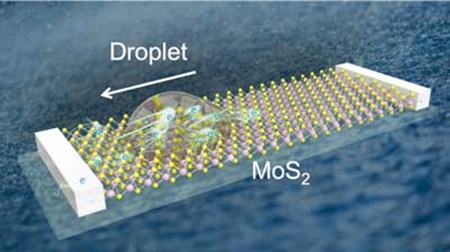|
NOVIDADES
Energy harvesting, a technology to transform small quantities of naturally occurring energy (e.g. light, heat and vibration) into electricity, is gaining attention as a method to power the Internet of Things (IoT) devices. This technology helps reduce environmental impacts and has a potential to power electronic devices in a stable and long-term manner, unlike batteries that need recharging or replacing. Researchers at Nagoya University and Kyushu University focused on energy from the tiny movement of liquid and developed a device that generates over 5 volts of electricity directly from the movement of a liquid droplet. This device, made of flexible thin films, generates electricity when drops of water slide down on its upper surface. This technology is expected to be applied to self-powered devices used in liquids, including sensors monitoring the quality of wastewater from factories. Their findings have been published in the journal Nano Energy ("High output voltage generation of over 5 V from liquid motion on single-layer MoS2").  A droplet moving on MoS2 generates the voltage as high as 5 V. Image: Adha Sukma Aji
The research group, consisting of Nagoya University's Adha Sukma Aji, Ryohei Nishi, and Yutaka Ohno and Kyushu University's Hiroki Ago, has demonstrated that using molybdenum disulfide (MoS2) instead of graphene as the active material in the generator makes it possible to generate over 5 volts of electricity from a liquid droplet. "To use MoS2 for the generator, it was necessary to form a large-area single-layer MoS2 film on a plastic film. With conventional methods, however, it was difficult to grow MoS2 uniformly on a large-area substrate," says Professor Ohno of the Institute of Materials and Systems for Sustainability at Nagoya University. "In our study, we succeeded in fabricating this form of MoS2 film by means of chemical vapor deposition using a sapphire substrate with molybdenum oxide (MoO3) and sulphur powders. We also used a polystyrene film as a bearing material for the MoS2 film, so that we were able to transfer the synthesized MoS2 film to the surface of the plastic film quite easily." Professor Ohno says, "Our MoS2 nanogenerator is able to harvest energy from multiple forms of liquid motion, including droplets, spraying, and sea waves. From a broader perspective, this device could also be used in applications involving hydrodynamics, such as generating electricity from rainwater and waterfalls." Nagoya University. Accessed: Feb. 21, 2020.
|
|||||||||||||||||||||||||